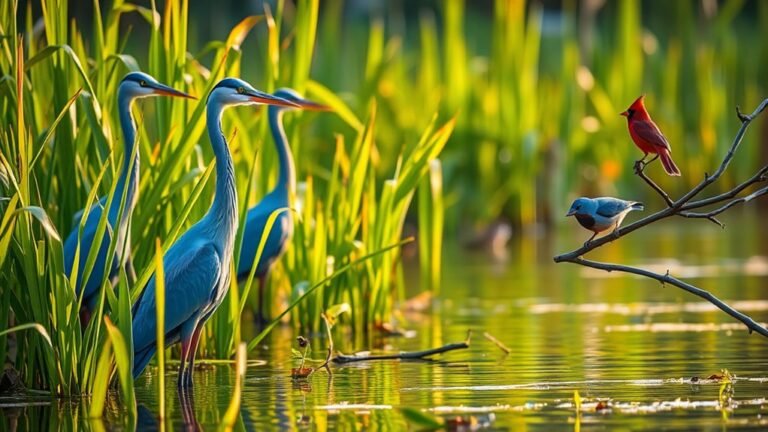What Is in the Sky When the Birds Don’t Fly? Weather and Migration Insights
When birds aren't flying, the sky shows signs of changing weather. Temperature changes, sudden storms, and strong winds can impact their migration. These factors not only determine where birds go but also when they start their journeys. Observing how weather affects bird behavior can highlight important connections between nature and migration. But what happens when the weather becomes unpredictable?
Key Takeaways
Weather fronts and pressure system changes affect bird migration patterns. Cold fronts can lower temperatures, causing birds to postpone their migration. Warm fronts usually create favorable conditions that encourage birds to migrate freely. Sudden shifts in temperature may disrupt their planned routes and timing. Climate change is also shifting migration schedules, making it harder for birds to adjust to new weather patterns. This impact on migration emphasizes the interplay between weather and bird behavior, highlighting the importance of understanding these changes.
Understanding Bird Migration Patterns
When you see a flock of birds flying south for the winter, you may wonder about their migration patterns. Birds migrate to find better nesting areas. They travel long distances to reach places that provide food and suitable conditions for their young.
For example, the Arctic Tern follows a yearly route to benefit from seasonal changes. These migrations depend on cues from the environment, such as changes in temperature and daylight.
Learning about these patterns shows how birds adapt and how ecosystems maintain balance. By understanding their journeys, you can appreciate the connections between different wildlife and the important roles each species plays in nature.
The Role of Seasonal Changes
Seasonal changes greatly affect animal behavior and migration. You can see how these shifts trigger migration for many species.
For example, as summer turns to autumn, changes in daylight and food availability cause birds to start their long journeys. When spring arrives, these birds return, motivated by new habitats and better feeding conditions.
Research shows that animals' hormonal changes help them align their migration with environmental factors. Understanding these connections enhances your appreciation of how closely we're linked to nature, fostering a deeper sense of community in our surroundings.
How Temperature Influences Migration
Temperature changes significantly affect migration patterns of many species. Specific temperature levels trigger movement. For example, when temperatures rise consistently, many bird species start to migrate earlier than usual.
Conversely, sudden drops in temperature can delay or reverse typical migration routes. These changes can impact food availability and breeding.
Migratory species depend on environmental signs to navigate their journeys. Recognizing how temperature influences migration helps you understand the connections within ecosystems.
This awareness fosters a deeper appreciation for nature and its cycles. Observing these shifts highlights the importance of being in tune with the natural world.
Weather Fronts and Their Impact on Birds
Weather fronts are important for bird migration. These fronts involve changes in pressure systems and affect temperature. A cold front can cause temperature drops, leading some birds to delay migration or change their routes.
On the other hand, warm fronts create good conditions for flight, encouraging birds to migrate. Understanding how weather fronts affect migration behavior helps people connect with birds.
The Connection Between Wind Patterns and Avian Travel
Understanding how wind patterns affect bird migration is vital for studying their movement.
Wind plays a key role in migration routes. Favorable winds help birds by reducing their energy use on long flights. This allows them to travel farther with less effort. In contrast, strong headwinds can force birds to change their paths or delay their migration.
Birds like the Arctic Tern make use of strong wind currents to optimize their routes. This behavior shows how they adapt to their environment.
The Effect of Rain and Storms
Rain and storms significantly influence bird migration.
Rain can cause birds to change their routes or pause their journeys. Heavy rain reduces visibility and increases the energy birds need to travel.
During storms, birds look for shelter to wait out strong winds and heavy rain. This behavior helps them avoid injury and fatigue.
Additionally, storms can push birds off their usual paths, sometimes leaving them in unfamiliar areas.
Understanding how weather affects bird migration helps us appreciate their resilience and connection to nature.
Habitat and Resource Availability
Bird migration patterns change due to seasonal shifts and human impact on habitats. When urban development or agriculture reduces habitats, birds find it harder to locate places for breeding and foraging.
This lack of suitable sites causes increased competition for resources among different bird species, which may lead to changes in their migration routes or timing. Research indicates that when food becomes scarce, birds are less likely to migrate, affecting their ability to survive and reproduce.
Habitat fragmentation also disrupts the paths birds need during migration, making it difficult for them to find necessary resources. Understanding these factors helps us appreciate the balance that supports bird life in an environment that's constantly changing.
Climate Change and Its Implications for Migration
As climate change increases, it affects bird migration patterns significantly. The timing of migrations changes, causing birds to arrive at their destinations earlier or later than usual. This shift can endanger their survival as food sources may become limited or breeding times may close. Some bird species adapt to these changes, but many face increasing challenges in their environments.
Conservation efforts must focus on these shifts in migration. Promoting habitats that support bird migration is essential. By creating environments that help birds cope with these changes, you can ensure that future generations will enjoy bird migration.
Participating in these conservation efforts also supports animal communities and connects you to a larger environmental cause.
Observing Bird Behavior During Inclement Weather
Bird migration patterns shift because of climate change. This shift exposes birds to bad weather at crucial times. Observing birds during storms or strong winds can reveal how they behave. Use specific birdwatching techniques to learn about their actions.
Look for changes in their behavior, like seeking shelter and adjusting their feeding. These behaviors indicate how stressed they are. Birds often go to dense bushes or trees for protection from harsh weather. This shows their instinct to stay safe.
Frequently Asked Questions
Why Do Some Birds Stay Behind Instead of Migrating?
Some birds choose to stay instead of migrating for two main reasons: breeding and food. These birds may want to mate when conditions are right. They may also find enough food in their current location. By staying, they can ensure their survival and have successful offspring in a familiar area.
How Do Urban Environments Affect Bird Migration?
Urban areas create obstacles for bird migration, changing their routes and habitats. Birds are less common in cities because they lose places to live and face more dangers. This makes it harder for them to migrate successfully.
What Technologies Aid in Tracking Bird Migration?
You can track bird migrations using GPS and radar technology. Satellite imagery also helps deepen your understanding. Citizen science allows you to share important data, increasing insights into these amazing migration patterns.
Are There Differences in Migration Patterns Among Bird Species?
Migration patterns differ among bird species. Each species migrates based on triggers like food availability and weather conditions. These factors affect their travel routes. Birds have special traits that help them face migration challenges. This shows the variety in how different species migrate. Understanding these patterns gives us insight into their behaviors and needs.
How Does Light Pollution Influence Bird Behavior?
Light pollution significantly affects bird behavior, especially in urban areas at night. Artificial light can confuse migratory birds. This confusion can lead to disorientation and higher death rates as birds find it harder to move through their environments during nighttime travel. Such conditions impact their survival and overall well-being. Understanding these effects can help raise awareness about the importance of reducing light pollution for the benefit of wildlife.

Ava is a bird enthusiast and nature lover who has spent countless hours observing and learning about the fascinating world of birds. With a passion for sharing her knowledge and inspiring others to appreciate the beauty of birds, Ava writes about her experiences and insights on avianadmirer.com.







